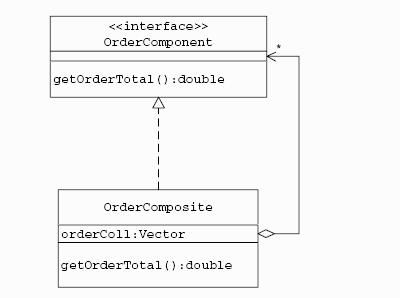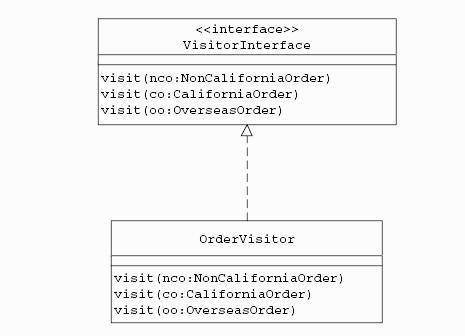18
VISITOR
This pattern was previously described in GoF95.
DESCRIPTION
The Visitor pattern is useful in designing an operation across a heterogeneous collection of objects of a class hierarchy. The Visitor pattern allows the operation to be defined without changing the class of any of the objects in the collection. To accomplish this, the Visitor pattern suggests defining the operation in a separate class referred to as a visitor class. This separates the operation from the object collection that it operates on. For every new operation to be defined, a new visitor class is created. Since the operation is to be performed across a set of objects, the visitor needs a way of accessing the public members of these objects. This requirement can be addressed by implementing the following two design ideas.
Design Idea 1
Every visitor class that operates on objects of the same set of classes can be designed to implement a corresponding VisitorInterface interface. A typical VisitorInterface declares a set of visit(ObjectType) methods, one for each object type from the object collection. Each of these methods is meant for processing instances of a specific class. For example, if the object collection consists of objects of ClassA and ClassB, then the VisitorInterface interface would declare the following two methods:
visit(ClassA objClassA)
for processing ClassA objects.
visit(ClassB objClassB)
for processing ClassB objects.
Every object from the object collection makes a call to the r espective visit(ObjectType) method, passing itself as an argument. A typical implementer (visitor) of the VisitorInterface can access the information required for the operation it is designed for by accessing the public members (methods and attributes) of the object instance passed to it through the visit method call.
Design Idea 2
Classes of objects from the object collection need to define a method:
accept(visitor)
A client interested in executing the visitor operation needs to:
- Create an instance of the implementer (visitor) of the VisitorInterface interface that is designed to carry out the required operation.
- Create the object collection and invoke the accept(visitor) method on every member of the object collection by passing the visitor instance created above.
As part of the accept(visitor) method implementation, every object in the object collection invokes the visit(ObjectType) method on the visitor instance. Inside the visit(ObjectType) method, the visitor gathers the required data from the object collection to perform the operation it is designed for.
DEFINING NEW OPERATIONS ON THE OBJECT COLLECTION
Whenever a new operation is to be defined across the object collection, a new visitor class needs to be created with implementation for the new operation. The visitor class needs to implement all of the visit(ObjectType) methods declared in the VisitorInterface interface to process different types of objects.
With this design, defining a new operation does not require any changes to the classes of the object collection.
ADDING OBJECTS OF A NEW TYPE TO THE COLLECTION
Whenever a new type of object is to be added to the object collection and is to be referred within the scope of an already existing visitor operation:
- The class of the object must provide a method similar to accept(visitor) and as part of this method implementation it should invoke the visit(ObjectType) method on the visitor object passing itself as an argument to it.
- A corresponding visit(ObjectType) method needs to be added to the VisitorInterface interface and needs to be implemented by all the concrete visitor classes.
This means that for objects of an existing class to be added to the object collection and to be considered within the scope of an existing visitor operation, the class needs to be altered to implement a method similar to accept(visitor), if one does not already exist. This implies that when the Visitor pattern is applied for the first time to a class, one should have access to its source code or the class needs to be subclassed to add the accept(visitor) method implementation.
EXAMPLE
Let us design an application to define operations over a collection of different Order objects. Orders can be of different types. Let us consider three different types of orders as follows:
- Overseas order — Order from countries other than the United States.
Additional shipping and handling is charged for this type of order. - California order — U.S. order with shipping address in California. Additional sales tax is charged on this type of order.
- Non-California order — U.S. order with shipping address not in California.
Additional sales tax is not applicable.
DESIGN APPROACH I
Let us assume that we would like to define an operation getMaxCAOrderAmount to find the top dollar amount on a California order. We can define a generic Order class as in the following Figure 18.1.
The Order class maintains a static member variable orderTotalCA to keep track of the order amount. Whenever a new order is created, the orderTotalCA member variable is updated with the order amount if the new order amount is greater than the old order total already available in the orderTotalCA static member variable.
Let us say that we would like to add more methods, such as getMinCA-OrderAmount, getCAOrderTotal, getMinNonCAOrderAmount, getMax- OverseasOrderAmount, etc., to find out different types of order amounts.
The Order class code needs to be altered for each such new operation. As a result, the class can quickly become cluttered (Figure 18.2).
| Order |
| orderTotalCA:double |
| getMaxCAOrderAmount():double |
Figure 18.1 Order Class
| Order |
| orderTotalCA:double |
| orderTotalNonCA:double |
| getMaxCAOrderAmount():double |
| getMinCAOrderAmount():double |
| getMaxNonCAOrderAmount():double |
| getMinNonCAOrderAmount():double |
Figure 18.2 Order Class with New Methods
DESIGN APPROACH II
Since orders are of three different types, we can design three subclasses of the Order class, each representing a specific order type (Figure 18.3).
With this new design, related operations can be kept within an appropriate Order subclass. Although this class structure is more manageable and less cluttered, it suffers from the following two limitations:
- There is no appropriate place to define operations involving different order types.
- Whenever a new operation is to be defined in any Order class, it requires a change to the class code.
DESIGN APPROACH III (COMPOSITE PATTERN)
During the discussion of the Composite pattern, we defined operations on an object collection containing objects from a class hierarchy. A Composite object is designed to maintain this object collection and operate on this collection.
Applying the Composite pattern, we can define a composite OrderComposite class as in Figure 18.4 to define operations on a collection of different order objects.

Figure 18.3 Order Class Hierarchy

Figure 18.4 OrderComposite: Class Structure
The attribute orderColl can be used to store different types of Order objects and the getOrderTotal iterates over this collection to retrieve and sum up different order amounts.
This design does not fully address the limitations of the Design Approach II. It allows the definition of an operation over a heterogeneous collection of objects, but it requires changes to the OrderComposite hierarchy classes whenever a new operation is to be added.
DESIGN APPROACH IV (THE VISITOR PATTERN)
Let us define an order class hierarchy as in Figure 18.5 with an interface Order at the top of the hierarchy and three of its implementers — CaliforniaOrder, NonCaliforniaOrder and OverseasOrder — each representing a specific order type. The Order interface declares a method accept(OrderVisitor). Each of the Order implementers provides implementation for the accept(OrderVisitor) method (Listings 18.1 through 18.4).
The VisitorInterface can be designed as a Java interface that declares a set of visit(OrderType) methods, one for each class in the order class hierarchy. In other words, these methods are meant to process different types of orders.
public interface VisitorInterface {
public void visit(NonCaliforniaOrder nco);
public void visit(CaliforniaOrder co);
public void visit(OverseasOrder oo);
}

Figure 18.5 Order Class Hierarchy
Listing 18.1 Order Interface
public interface Order {
public void accept(OrderVisitor v);
}
Let us define a visitor OrderVisitor as an implementer of the VisitorInterface (Figure 18.6 and Listing 18.5), to calculate the sum of all order totals.
As part of its implementation of the VisitorInterface methods, the OrderVisitor retrieves the order amount, any additional tax or shipping and handling amounts from different Order objects and maintains a cumulative sum of these amounts in a private instance variable orderTotal.
Application Flow
When run, the client OrderManager creates an instance of the OrderVisitor and displays the necessary user interface to allow a user to create different types of orders (Figure 18.7).
Listing 18.2 CaliforniaOrder Class
public class CaliforniaOrder implements Order {
private double orderAmount;
private double additionalTax;
public CaliforniaOrder() {
}
public CaliforniaOrder(double inp_orderAmount,
double inp_additionalTax) {
orderAmount = inp_orderAmount;
additionalTax = inp_additionalTax;
}
public double getOrderAmount() {
return orderAmount;
}
public double getAdditionalTax() {
return additionalTax;
}
public void accept(OrderVisitor v) {
v.visit(this);
}
}
Listing 18.3 NonCaliforniaOrder Class
public class NonCaliforniaOrder implements Order {
private double orderAmount;
public NonCaliforniaOrder() {
}
public NonCaliforniaOrder(double inp_orderAmount) {
orderAmount = inp_orderAmount;
}
public double getOrderAmount() {
return orderAmount;
}
public void accept(OrderVisitor v) {
v.visit(this);
}
}
Listing 18.4 OverseasOrder Class
public class OverseasOrder implements Order {
private double orderAmount;
private double additionalSH;
public OverseasOrder() {
}
public OverseasOrder(double inp_orderAmount,
double inp_additionalSH) {
orderAmount = inp_orderAmount;
additionalSH = inp_additionalSH;
}
public double getOrderAmount() {
return orderAmount;
}
public double getAdditionalSH() {
return additionalSH;
}
public void accept(OrderVisitor v) {
v.visit(this);
}
}
Every time a user enters the order data and clicks on the CreateOrder button, the client OrderManager (Listing 18.6):
- Creates an Order object with the input data.
- Invokes the accept(OrderVisitor) method on the Order object by passing the OrderVisitor object. The Order object internally calls the OrderVisitor visit method by passing itself as an argument. The OrderVisitor retrieves the required order amount, tax and shipping amounts using the public methods defined by different Order classes and adds these amounts, in a cumulative manner, to the order total kept inside the private instance variable orderTotal.
When the GetTotal button is clicked, the client OrderManager invokes the getOrderTotal method of the OrderVisitor. The OrderVisitor simply returns the value stored in the orderTotal instance variable, which is the total value of all orders created.
The sequence diagram in Figure 18.8 depicts the message flow, when the client OrderManager makes use of the visitor OrderVisitor to calculate the grand total of a set of different order amounts. In order to keep the diagram simple, only one type of order is included.

Figure 18.6 OrderVisitor Class Structure
DEFINING A NEW OPERATION ON THE ORDER OBJECT COLLECTION
Defining a new operation on the order object collection requires the creation of a new visitor. The new visitor needs to implement the VisitorInterface interface providing implementation for different visit(OrderType) methods to process different types of Order objects.
ADDING A NEW ORDER TYPE TO THE COLLECTION
If a new type of object (a new class) is to be added to the object structure such as a DiscountOrder that implements the Order interface, then a corresponding visit(DiscountOrder) method needs to be added to the VisitorInterface and needs to be implemented by the OrderVisitor class.
PRACTICE QUESTIONS
1. As part of our discussion of the Composite pattern, we designed a composite DirComponent class. Redesign the DirComponent class operations applying the Visitor pattern.
2. The Practice Questions section of the Composite pattern discussion lists three applications involving operations on a heterogeneous object collection. Apply the Visitor pattern in designing these operations.
Listing 18.5 OrderVisitor Class
class OrderVisitor implements VisitorInterface {
private Vector orderObjList;
private double orderTotal;
public OrderVisitor() {
orderObjList = new Vector();
}
public void visit(NonCaliforniaOrder inp_order) {
orderTotal = orderTotal + inp_order.getOrderAmount();
}
public void visit(CaliforniaOrder inp_order) {
orderTotal = orderTotal + inp_order.getOrderAmount() +
inp_order.getAdditionalTax();
}
public void visit(OverseasOrder inp_order) {
orderTotal = orderTotal + inp_order.getOrderAmount() +
inp_order.getAdditionalSH();
}
public double getOrderTotal() {
return orderTotal;
}
}

Figure 18.7 Order Manager: User Interface to Create Orders
Listing 18.6 OrderManager Class
…
…
public void actionPerformed(ActionEvent e) {
String totalResult = null;
if (e.getActionCommand().equals(OrderManager.EXIT)) {
System.exit(1);
}
if (e.getActionCommand().equals(OrderManager.CREATE_ORDER)
) {
//get input values
String orderType = objOrderManager.getOrderType();
String strOrderAmount =
objOrderManager.getOrderAmount();
String strTax = objOrderManager.getTax();
String strSH = objOrderManager.getSH();
double dblOrderAmount = 0.0;
double dblTax = 0.0;
double dblSH = 0.0;
if (strOrderAmount.trim().length() == 0) {
strOrderAmount = "0.0";
}
if (strTax.trim().length() == 0) {
strTax = "0.0";
}
if (strSH.trim().length() == 0) {
strSH = "0.0";
}
dblOrderAmount =
new Double(strOrderAmount).doubleValue();
dblTax = new Double(strTax).doubleValue();
dblSH = new Double(strSH).doubleValue();
//Create the order
Order order = createOrder(orderType, dblOrderAmount,
dblTax, dblSH);
//Get the Visitor
OrderVisitor visitor =
objOrderManager.getOrderVisitor();
//accept the visitor instance
order.accept(visitor);
objOrderManager.setTotalValue(
" Order Created Successfully");
}
if (e.getActionCommand().equals(OrderManager.GET_TOTAL)) {
//Get the Visitor
OrderVisitor visitor =
objOrderManager.getOrderVisitor();
totalResult = new Double(
visitor.getOrderTotal()).toString();
totalResult = " Orders Total = " + totalResult;
objOrderManager.setTotalValue(totalResult);
}
}
public Order createOrder(String orderType,
double orderAmount, double tax, double SH) {
if (orderType.equalsIgnoreCase(OrderManager.CA_ORDER))
{
return new CaliforniaOrder(orderAmount, tax);
}
if (orderType.equalsIgnoreCase(
OrderManager.NON_CA_ORDER)) {
return new NonCaliforniaOrder(orderAmount);
}
if (orderType.equalsIgnoreCase(
OrderManager.OVERSEAS_ORDER)) {
return new OverseasOrder(orderAmount, SH);
}
return null;
}
…
…

Figure 18.8 Application Message Flow
